#the quarterback 1926
Text


Born in St. Paul, Minnesota, in 1894. His real name is Ernest Brimmer, and he was trained to be a surgeon. However, he went into a bank, and after a spell in an architect's office he decided to go on the stage. Had some experience with a stock company before going on the films. Has played reading roles in many pictures, among which are "The Ten Commandments," "The Christian," "Womanhandled," "The Quarterback" and "Easy Come, Easy Go."
#richard dix#vintage cigarette card#from my collection#the ten commandments 1923#the christian 1923#womanhandled 1925#the quarterback 1926#easy come easy go 1928
1 note
·
View note
Text

Mona Palma was an actress born September 26th 1897 in New York City. She was known for The Canadian (1926), Fascinating Youth (1926) and The Quarterback (1926). She died in Oxnard, California in 1989.
17 notes
·
View notes
Text
Y.A. Tittle: The Gunslinger Who Redefined Quarterback Play
When discussing the greatest quarterbacks in NFL history, the name Y.A. Tittle often comes up, and for good reason. A pioneer in the art of quarterbacking, Tittle was more than just a great player; he was a trailblazer who helped shape the modern passing game. Known for his toughness, leadership, and precision, Tittle’s impact on the NFL is still felt today, decades after he last took a snap.
Early Life and Rise to Football Stardom
Born on October 24, 1926, in Marshall, Texas, Yelberton Abraham Tittle Jr., or Y.A. Tittle, as he became known, showed an early aptitude for football. He played high school football in Marshall, where his talent as a quarterback quickly became apparent. After high school, Tittle went on to play college football at LSU, where he continued to develop his skills and gained national attention for his performances on the field.
At LSU, Tittle’s passing ability began to shine. He led the Tigers to victories in the 1947 Cotton Bowl Classic and the 1949 Sugar Bowl, cementing his reputation as one of the best college quarterbacks in the country. His strong arm and football IQ made him a top prospect, and in 1948, he was drafted by the Detroit Lions in the NFL and the Baltimore Colts in the All-America Football Conference (AAFC). Tittle chose to sign with the Colts, beginning his professional career.
Professional Career: The Long Road to Greatness
Tittle’s professional career began with the AAFC’s Baltimore Colts, but it wasn’t until he joined the San Francisco 49ers in 1951 that he truly began to make his mark. Over a decade with the 49ers, Tittle developed into one of the league’s premier passers. He was a key figure in the team’s famed “Million Dollar Backfield,” alongside stars like Hugh McElhenny, Joe Perry, and John Henry Johnson.
Tittle’s time with the 49ers was marked by consistent success, though the team never quite reached the pinnacle of the NFL during his tenure. Despite this, Tittle’s performances were extraordinary. He was known for his deep throws, quick decision-making, and leadership on the field. Tittle earned multiple Pro Bowl selections and became one of the most respected quarterbacks in the league.
However, it wasn’t until he was traded to the New York Giants in 1961 that Tittle truly ascended to the peak of his career.
The Giants Era: Record-Breaking Seasons
Tittle’s move to the New York Giants proved to be the turning point of his career. At an age when many players were considering retirement, Tittle found a new gear. He led the Giants to three consecutive NFL Championship Game appearances from 1961 to 1963, redefining what it meant to be a quarterback in the process.
The 1962 and 1963 seasons, in particular, were nothing short of legendary. In 1962, Tittle threw for a then-record 33 touchdown passes. He shattered his own record the following year, throwing 36 touchdown passes and earning the NFL Most Valuable Player (MVP) award. His performances helped the Giants dominate the league, and his duels with other top quarterbacks of the era became the stuff of legend.
Tittle’s ability to read defenses, combined with his pinpoint accuracy and fearless attitude, made him one of the most dangerous quarterbacks in the NFL. Even as he approached the end of his career, Tittle continued to play at an elite level, cementing his place as one of the game’s all-time greats.
The Famous Photo: A Symbol of Grit
One of the most iconic images in NFL history is a photograph of Y.A. Tittle, taken during a game against the Pittsburgh Steelers in 1964. The photo shows Tittle on his knees, bloodied and helmetless, after a brutal hit. His head is bowed, and his expression is one of pain and exhaustion — a stark representation of the physical and emotional toll of the game.
This photograph has come to symbolize the grit, determination, and toughness that defined Tittle’s career. Despite the beating he took on the field, Tittle never wavered in his commitment to the game. That image is a reminder of the sacrifice and passion that are at the heart of professional football.
Legacy: A Pioneer of the Passing Game
Y.A. Tittle retired after the 1964 season, but his influence on the game did not end with his playing days. Tittle was a pioneer of the modern passing game, helping to popularize the idea of the quarterback as a field general who could take over a game with his arm. His innovative approach to the position laid the groundwork for the high-flying offenses that would come to dominate the NFL in the decades that followed.
Tittle’s legacy is enshrined in the Pro Football Hall of Fame, where he was inducted in 1971. His career statistics — 33,070 passing yards and 242 touchdown passes — were remarkable for his era, and his impact on the game is still felt today.
Conclusion: A True NFL Legend
Y.A. Tittle was more than just a great quarterback; he was a trailblazer who helped shape the modern NFL. His toughness, leadership, and skill set a new standard for the position and earned him a place among the all-time greats. Even today, decades after his retirement, Tittle’s legacy lives on in the quarterbacks who follow in his footsteps, trying to match the greatness that he achieved.
In the pantheon of NFL legends, Y.A. Tittle stands tall — a reminder of what it means to be a true competitor and a pioneer in the world of professional football.
0 notes
Photo

Yelberton Abraham Tittle Jr. (October 24, 1926 – October 8, 2017) was a professional American football quarterback. He played in the National Football League (NFL) for the San Francisco 49ers, New York Giants, and Baltimore Colts, after spending two seasons with the Colts in the All-America Football Conference (AAFC). Known for his competitiveness, leadership, and striking profile, Tittle was the centerpiece of several prolific offenses throughout his 17-year professional career from 1948 to 1964.
Tittle played college football for Louisiana State University, where he was a two-time All-Southeastern Conference (SEC) quarterback for the LSU Tigers football team. As a junior, he was named the most valuable player (MVP) of the infamous 1947 Cotton Bowl Classic—also known as the "Ice Bowl"—a scoreless tie between the Tigers and Arkansas Razorbacks in a snowstorm. After college, he was drafted in the 1947 NFL Draft by the Detroit Lions, but he instead chose to play in the AAFC for the Colts.
With the Colts, Tittle was named the AAFC Rookie of the Year in 1948 after leading the team to the AAFC playoffs. After consecutive one-win seasons, the Colts franchise folded, which allowed Tittle to be drafted in the 1951 NFL Draft by the 49ers. Through ten seasons in San Francisco, he was invited to four Pro Bowls, led the league in touchdown passes in 1955, and was named the NFL Player of the Year by the United Press in 1957. A groundbreaker, Tittle was part of the 49ers' famed Million Dollar Backfield, was the first professional football player featured on the cover of Sports Illustrated, and is credited with having coined "alley-oop" as a sports term.
Considered washed-up, the 34-year-old Tittle was traded to the Giants following the 1960 season. Over the next four seasons, he won several individual awards, twice set the league single-season record for touchdown passes, and led the Giants to three straight NFL championship games. Although he was never able to deliver a championship to the team, Tittle's time in New York is regarded among the glory years of the franchise.
In his final season, Tittle was photographed bloodied and kneeling down in the end zone after a tackle by a defender left him helmetless. The photograph is considered one of the most iconic images in North American sports history. He retired as the NFL's all-time leader in passing yards, passing touchdowns, attempts, completions, and games played. Tittle was inducted into the Pro Football Hall of Fame in 1971, and his jersey number 14 is retired by the Giants.
4 notes
·
View notes
Text
Rocka My Soul
Rocka My Soul
“Rocka My Soul in the Bosom of Abraham” is a song about being close to and in the comfort of God. It is primarily sung in African-American churches, but on the night of December 12th, 1981, the majority of the 76,000 plus fans at Rice Stadium, black and white, were standing, singing the song in unison. They were singing to inspire on the Jack Yates High School Lions, who were seeking to become the first all African-American football team to make it to the Texas state championship since high school sports were desegregated in 1969.
If you were fortunate enough to be at Rice Stadium that night, you just knew that it was more than a football game – it was a celebration of a transformative journey. The energy in the stadium was powerful in the most beautiful of ways - it hit you in your heart and in your soul. It emanated love, passion, resilience, redemption, and the power of community
Background
John Henry “Jack” Yates, for whom Jack Yates High School was named, was a leader, educator, a community builder, and man of vision. Born into slavery on July 11th, 1828 in Gloucester County, Virginia, Jack Yates taught himself to read and write, and also mastered carpentry.
When Texas became the last state to end slavery on June 19th, 1865, Jack Yates and his wife Harriet moved to Houston. He became the first minister of Antioch Missionary Baptist Church, the center of political, cultural, social and educational life for the flourishing community of free black men and women. Deeply committed to building community and to empowering that community through education, Reverend Yates founded the Baptist Academy (the forerunner to Texas Southern University), which focused on preparing students for careers in business and the ministry.
Jack Yates Colored High School opened its doors in 1926. In the early 1980s, the school was at the center of a vibrant, engaged ecosystem of teachers, students, parents, alumni and the broader community. And the bonds that were the basis of the Jack Yates community in the 1980s are as strong now as they were back then. There is a frequently used expression “JY4Life” which captures the essence of what it meant and still means to be part of the Jack Yates community. It is hard to overstate the pride and deep sense of connection that Yates alumni still feel towards the school and towards one another.
Lori Dee Mack, a criminal defense attorney in Houston, was a cheerleader and editor of the yearbook at Jack Yates in 1981. “Yates just had a special vibe to it, we were the cool school,” Ms. Mack said. “Part of what made it so special was the involvement of the community. We were expected to make something positive out of our lives, and those expectations were reinforced by our community.” Jackie Clark was a senior and the majorette on the acclaimed Jack Yates marching band in 1981. “Our parents and our teachers knew one another, expected a lot from us, and they worked together to ensure that we performed in the classroom and were good representatives of our community,” Ms. Clark stated.
The Yates sports teams were the focal point for community engagement, football in particular. From the beginning, the school was successful in football, wining four Prairie View Interscholastic Negro League state titles. Since the end of segregation, however, only once had the Lions advanced past the first round in the playoffs.
In spite of the playoff history, expectations were high going into the 1981 season. Several starters at key positions returned from a team that went undefeated during the 1980 regular season - quarterback Thomas LeDet, offensive linemen Rodney Henry and John Simmons, wide receivers Jeffrey Fields and Keith Burnett, middle linebacker Sebastian Harris (who made All-City his junior year), defensive linemen Stephen Baker and kicker/safety Lemuel Moton. That core group would be bolstered by several key additions, including defensive lineman Eddie Gilmore (who had to sit out his junior season after transferring from Sterling High School) and running back/wide receiver Randolph Wilburn, who transferred from Lincoln High School which closed in the spring of 1981.
Preparation for the 1981 season began in May with spring training, and continued throughout the summer. LeDet, who came into his own at the end of the 1980 season, wanted to make sure that he and his teammates were fully prepared going into the 1981 season. He organized practices with his receiving corps that summer. “I wanted for us to get comfortable working with one another and to get our timing down,” LeDet stated.
High school teammates working out together during the summer is now routine in Texas, but in the early 1980s it was not common. Little did LeDet or his teammates know how prescient these self-organized summer sessions would turn out to be.
The Season
The season began as expected, with a win over Worthing High School.
The following week the Lions suffered a stunning and crushing defeat at the hands of Smiley High School. That loss, however, would prove to be the turning point of the season. “We needed that loss,” John Simmons stated. “It made us realize that we were not as good as we thought we were, and that we need to get focused if we were going to accomplish our goal, which was to win the state championship.”
In that game, Smiley RB John Stewart ran roughshod over the Lions defense. To this day Sebastian Harris is livid about the loss to Smiley. Harris is a smart, thoughtful, proud man who still looks like he could level an NFL running back. “We were out hit that game,” he says, with both surprise and disappointment. John just ran all over us, we had never experienced a running back with such speed, power and determination. The gentlemen just set the tone and had his way the entire game.”
The next week in practice 2nd year linebacker coach Coger Coverson, a former Washington Redskins offensive guard and Yates alum, declared that every position on defense was open. Practice started with the intense and savage bullring drill (this is the drill where one player is in the middle of a ring and takes on other players in rapid sequence). It was perhaps the most intense week of practice during our time at Yates.” That week set the tone for the rest of the season, as the Harris, Stephen Baker and Eddie Gilmore led defense would pitch 5 shutouts on the way to allowing just over 10 points per game the rest of the season.
Offensively, Smiley had stacked the line of scrimmage, daring the Lions to beat them with the passing game. Yates was historically a power running team, and Coach Luther Booker was loath to abandon the run. The Lions finally began passing in the 4th quarter, but by then it was too late. Yet Booker saw enough that game to convince him to let LeDet and the passing game become the focal point of the offense. “We discovered that we had good quarterback that game,” John Simmons said. The investment LeDet and his receivers made that summer was about to pay-off in a profound way.
Under LeDet’s leadership the offense exploded, averaging almost 30 points per game the remainder of the season. In an era where the running game was focal point of most offenses, the Lions wide-open and vertical passing game was novel and exciting. In addition to Fields, Burnett and Wilburn (who had moved from running back to wide receiver), LeDet had wide receiver Rayfield Gee and powerful tight ends in Sylvester Morgan and Leonard Moon. LeDet would go on to have the sixth most productive passing season in Houston high school football history.
As the season progressed and the Lions advanced in the playoffs, the city of Houston began to take notice. The Lions explosive offense, dominating defense and high-flying marching band were a weekly show that was hard to beat. “As we started winning everyone wanted to be associated with us,” Harris said. “Radio stations, newspaper reports, television stations – they were around us all of the time.”
From a purely entertainment perspective, the highlight of the season came when the Lions went head to head with the famous “Who Shot JR” episode of Dallas, which at the time was the highest viewed television show in US history. “I remember Saturday November 21st - that was the night that the “Who Shot JR” episode aired, Mack said. “We were playing Booker T Washington in bi-district at the Astrodome and the stadium was packed. We went head to head with one of the most watched television shows of all time and won,” she said laughingly.
Blacks and whites lived in separate worlds during those days in Houston. When their worlds intersected, it was often confrontational. There was a clear lack of trust and understanding between the two communities. Yet somehow the Lions performance was able to transcend race and bring those two worlds together, at least for a period of time.
“When I was a teenager, I did encounter some forms of subtle prejudice, Thomas LeDet said. “However, I learned to ignore it. But for many of my teammates and friends, racism was hard to ignore. The stares we encountered when we entered a sporting goods store, personnel following you around, etc. But that changed when we beat Aldine in the quarterfinals.”
“ I remember walking into Foleys’ department store with my teammates Jeffrey Fields and Kenneth Wiley after we beat Aldine in the quarterfinals. We were wearing our letterman jackets. As we entered the store, we noticed a distinct change on the part of the personnel - instead of suspicious and concerned faces there were smiles accompanied by quick service and people asking us if they could help us. Shortly after entering the store, a middle age white woman hurried over to my side and pointed to a Volkswagen size photo on the upper banister right in the entrance of the store. It was a picture of the entire team and staff of the 1981/82 Jack Yates football team! Needless to say, we stood speechless for a moment and then were elated. We knew at that moment that we were something special not just to the black community, but also to the entire city. “
“I remember during the playoffs a very popular white radio station (104 KRBE) was broadcasting live from the Jack Yates School of Communications. Quite a few students told me as I walked towards the lunchroom that the DJ was looking for me. As I approached, he announced, "Here he comes the man of the hour.... Mr. Thomas LeDet, the quarterback for Jack Yates High School. He began to ask me questions about our season and if I thought we were going to go all the way. It was exciting and fun, and at the end, the DJ asked me, what was my favorite radio station. As we both chuckled.... I said, as of today, KRBE is one of my favorites. And then the DJ playfully asked me if I had ever heard of 104 KRBE. We both laughed and I said no. At that point, he presented me with a trophy of a giant #1 symbol with the radio station call letters and “Congratulations on a Great Season” engraved. He went on to say that the radio station and the entire City of Houston were cheering for us in the upcoming regional championship. I was left with a feeling of joy and the sense that our team meant more to the city than just football.”
The Breakthrough
The Lions marched through the playoffs, defeating Booker T. Washington in bi-district, Houston Madison in the regional finals and Aldine in the quarterfinals. Next up? Perennial power San Antonio Churchill in the state semi-finals
The Chargers, who were led by quarterback Cody Carlson (Carlson would go on to star at Baylor University and play seven years in the NFL) and had a glorious history of advancing deep in the state playoffs, including winning the championship in 1976. They were heavily favored to defeat the Lions and advance to the state championship.
Fittingly, Rice Stadium was chosen as the site for the game. On September 12th, 1962, President Kennedy delivered his famous “We choose to go to the Moon” speech at Rice Stadium, a vision which was realized with the Apollo 11 mission in July 1969. Now, 19 plus years later, the stadium was again the site for another potential pivotal moment – if Yates could defy the odds and beat Churchill, they would become the first all African-American team to make it to the state championship.
The week leading up to the game was frenetic. “The whole community rallied behind the guys,” said Nanette “Nettie” Simmons, a cheerleader in 1981. “And it continued to and throughout the game. It was a cold and wet night, but I remember the stadium overflowing and people sitting on the grassy hill outside the stadium to watch the game.”
Churchill jumped out to a 14-0 lead, thanks to some great running by Doug Hodo, pinpoint passing by Cody Carlson, good play calling, and a bit of luck – the headsets on the Yates side were not working until the second quarter so Yates was not able to make defensive adjustments to counter the Chargers. Sebastian Harris rallied the defense, the Lions made adjustments and held Churchill scoreless the second quarter. Thomas LeDet and the offense got untracked, with LeDet throwing touchdown passes to Rayfield Gee and Keith Burnett. Churchill scored a safety to make the game 16-14 at halftime.
The week before Yates had trailed Aldine 14-0 before exploding for 42 straight points in a 42-14 win. But this game had a much different feel to it. “We knew we were in a fight. Those guys – Churchill – were tough and would not quit,” said both running back Artie Mitchell and punter Ronald Davis.
The second half was like a classic heavyweight boxing match, a la Rocky Balboa vs. Apollo Creed, with Yates ironically playing the role of Rocky. Churchill scored to go up 23-14 and looked to be on the verge of blowing the game open, when Harris rallied the defense and LeDet the offense. LeDet hit Keith Burnett with a 69-yard touchdown pass, ran for a score, and Harris forced a fumble which led to a Moton field goal. Suddenly Yates was up 31-23 with under 5 minutes left and it looked like they had all of the momentum.
Carlson and Churchill responded by driving to mid-field. Harris and the defense forced a 4th and 10 and a time-out was called by the officials to confirm the game statistics. In those days there was no overtime, in the event of a tie the team with the most 20-yard line penetrations and first downs advanced. Churchill was ahead in both.
On 4th and 10 Carlson completed a 47-yard pass to Harold Huggins. Three plays later Churchill scored to trail 31-29. Churchill then made a 2-point conversion on a tipped pass, and the score was 31-31. Less than 2 minutes remained.
LeDet led the offense to the 45-yard line, where three straight long passes to Burnett and Fields were incomplete. It was now 4th and 10, and arguably the most important play in the history of not only Yates football but perhaps for inner-city schools across the state of Texas was forthcoming. Since segregation in Texas high school sports ended in 1969, a widely held perception was that an all African-American football team lacked the intellect, discipline, mental toughness and adaptability to advance far in the playoffs. The Lions had been shattering that myth all year, winning by playing smart, disciplined football and adapting at key points during the season. Fittingly, for them to advance to the championship, they would once again have to call on these traits to convert, score and then hold Churchill in check.
“I told Thomas and Coach Booker that I was open underneath all game long,” said Randolph Wilburn. “Thomas and I convinced Coach Booker that Churchill would double cover Keith (Burnett) and Jeffrey (Fields), and to pass to me on an underneath route. We were confident that we could get the 10 yards and convert.”
Everyone was on their feet as LeDet approached the line of scrimmage. LeDet dropped back, avoided the Churchill rush and made a perfect throw to Wilburn, who caught the ball at the Churchill 45-yard line. Wilburn then put his running back skill to use, and thanks to blocking from Jeffrey Fields advanced the ball to the Churchill 20-yard line.
The Lions were well within kicker Lemuel Moton’s range, but this game was about making history, and they were not going to let a field goal determine their fate. “We had momentum and believed we could run the ball to victory,” said John Simmons. Behind crushing blocks from Simmons, Rodney Henry, Byron Strain, Phillip James, James Jackson and Sylvester Morgan, the Lions ran the ball 4 straight times, with LeDet scoring to put the Lions up 38-31.
However, there were 40 seconds left on the clock. And Churchill & Carlson had countered Yates all night long with big plays of their own.
As Ronald Davis lined-up to kick-off, the energy in the stadium as frenetic. There was no way that these fans and the spirits of the African-American men and women who paved the way for this moment were going to let the Lions falter. Reserve linemen Tracy Sandles pinned Churchill inside their own 10-yard line on the kick-off. On the ensuing play, Carlson never had time to get off a pass –Gilmore, Baker, and the passion and energy of the city of Houston sacked him in the end zone for a safety. Yates 40 Churchill 31!
As LeDet ran out the clock, students, teachers, alumni, and fans – black and white - from across the city of Houston poured onto the field to celebrate with the team. Rice Stadium was again the setting for a historical moment. It was not just that Yates become the first all African-American team to advance to the championship, it was how they did it. They shattered long-held racist myths about African-American teams lacking the intellect, character and discipline to advance.
LeDet was also a terrific role model for a new generation of African-American quarterbacks. Historically, when African-Americans were allowed to play quarterback it was as an option quarterback, not a pro-style quarterback. Barry Switzer at Oklahoma and Bill Yeoman at Houston were pioneers in allowing African-Americans to play quarterback, but those were in running offenses where the quarterback was essentially a running back. It seems hard to believe but the perception that African-Americans could not lead a pro-style offense (where the quarterback was responsible for making all key decisions – passing and running) delayed Hall of Fame quarterback Warren Moon’s entry to the NFL by 6 years.
The Aftermath and the Present Day
The Lions would go on to lose the state championship 19-6 to Richardson Lake Highlands the following week. The Lions had 8 turnovers and offensively were in a funk all game long. The Harris-led defense dominated Lake Highlands, effectively hold them to 12 points on 4 field goals. But it was just not meant to be.
However, the victory of breaking through and making it to state in the way they did had a powerful impact, one that went beyond the football field.
The relationship between educational attainment and Texas high school football is more often than not negatively correlated. However, the 81 team, in the spirit of Reverend Yates, helped reversed this relationship by helping awaken their community to educational possibilities.
“At first colleges sent athletic recruiters to Yates because of the success of the football team,” Lori Dee Mack said. “They quickly followed by sending academic recruiters, and all of a sudden we started to hear about schools like TCU, which we did not know existed. At the time we thought the only college options were local schools Texas Southern and the University of Houston. All of sudden were aware of all of these other schools – this just would not have been possible had the team not done so well and attracted the attention it did…”
“I wound-up going to TCU with 3 of my girlfriends, and other friends went to the University of Texas, Texas A&M, etc. It was really incredible how the team’s success opened doors for us students, “Mack stated. “It was also very comforting knowing that people from our community (Thomas LeDet and Keith Burnett went to TCU with Mack and her friends) were going to these schools.”
And the football team also set an example for the students. “I remember Coach Booker saying that 90% of the players he coached went-on to college,” Randolph Wilburn noted.
In 1985 the Lions would go undefeated and win the state championship, becoming the first all African-American football team to win a state championship in Texas post segregation. That team, which was led by running back Johnny Bailey, is widely considered to be the best team in the history of Texas high school football.
The path for the 85 team had been paved 4 years earlier by a remarkable group of young men. “The players on the 81 team had a sense of humility about them,” Mack said. “They didn’t let the attention go to their heads, and you just knew that they were going to do something positive with their lives.”
The magic of the 81 team’s journey continues to resonate to this day. Stella Hall, a cheerleader in 1981, currently works at MD Anderson Cancer Center. She was recently at a conference in Wisconsin and was speaking with a man who, when he found out she went to Jack Yates, asked her if she knew Thomas LeDet, Sebastian Harris and Jeffrey Fields. “He somehow knew about our school, the 81 team and the key guys on that team,” Stella said, shaking her head in disbelief.
Thomas LeDet was recently approached on two separate occasions – one by a former Yates student who graduated in the 1990s, the other by a former cafeteria worker from the University of Houston (LeDet worked at the University of Houston cafeteria while in school, serving the likes of Hakeem Olajuwon and Clyde Drexler). Both individuals wanted to tell LeDet how much the 81-team inspired them.
“At times it just seems incredible, he says, reflecting on the impact of the 81 team. We were just focused on winning on the field. It is really special to know that we inspired people.”
1 note
·
View note
Photo

1926 black and white print ad for the various films being produced by Paramount Pictures at the time, such as Tin Gods, Variety, You Never Know Women, Kid Boots, The Quarterback, The Campus Flirtand many more.
41 notes
·
View notes
Text
Players in the National Football League (NFL) can score points in a number of ways, including six-point touchdowns and three-point field goals. Teams that score a touchdown have the option of kicking a short field goal for an extra point or running a play in an attempt to score two points by making into the end zone. If a defensive team manages to tackle a ball carrier in their own end zone, the defensive team scores a two-point safety.
The 2021 NFL season saw its largest scoring drop in more than four decades and the second largest drop since the NFL merged with the American Football League. Following years of steadily increasing offensive outputs, league-wide average scoring fell from 24.8 during the 2020 NFL season to 23 in 2021. A two-point drop from 1976 to 1977 is the only comparable decrease in the sport’s history.
There are several possible reasons for this reduction in scoring average. For one thing, numerous starting quarterbacks missed time with COVID-19-related absences. That said, COVID-19 was an issue during 2020 as well, suggesting that the more influential factors involved improved defensive stats and an increase in holding calls. Finally, the 2021 season saw fans return to NFL stadiums without restrictions, making it more difficult for opposing teams to communicate over raucous home crowds.
Despite an upward trend in scoring over recent years, the drop brings NFL scoring closer to the historical norm, as teams averaged 22.8 points per game from 2013 through 2019. Teams during the 2020 season averaged nearly 5.8 touchdowns per game. Prior to that season, 2018 was the only year over the past two decades in which teams averaged more than 5.2 touchdowns. In comparison, teams scored an averaged of 4.6 touchdowns per game in 2000.
Scoring statistics change somewhat when taking into account all scoring metrics. For instance, there have been nine seasons since 2000 (including 2020) in which teams averaged more extra points than they did in 2018. As one might imagine, there were more two-point conversions in 2018 than any other season since 2000.
NFL teams have not averaged fewer than 20 points a game since 1994, when scoring jumped from 18.7 to 20.3 points per game. Scoring was far lower during the early days of the sport, with teams averaged single-digit scores in 10 of the league’s first 12 seasons. The 1926 season (the NFL’s fifth season) was the lowest scoring season of all time, with teams averaging 7.6 points per contest. This means the average game saw each team score a single touchdown and perhaps one additional extra point.
The highest scoring NFL game of all time was a 1966 meeting between the New York Giants and Washington Football Team, which Washington won by a score of 72-41, for a total of 113 points. Super Bowl XXIV in 1990 was the highest scoring championship game, with the San Francisco 49ers blowing out the Denver Broncos 55-10.
On the other hand, six of the seven lowest scoring Super Bowls occurred during the first nine NFL seasons. That said, the lowest scoring Super Bowl ever was Super Bowl LIII, in which the New England Patriots defeated the Los Angeles Rams 13-3.
via Blogger http://farooqshahzadwi.blogspot.com/2022/07/players-in-national-football-league-nfl.html
0 notes
Text
Van Dyke, VanDyke or Vandyke is an Americanized or anglicized form of the Dutch-language toponymic surname Van Dijk, Van Dijke, Van Dijck, or Van Dyck. It may refer to: Antony van Dyke, variant English spelling of the Flemish-born painter Anthony van Dyck, (1599–1641) The Van Dyke family of American entertainers:Dick Van Dyke (born 1925), actor Barry Van Dyke (born 1951), actor Shane Van Dyke (born 1979), actor, screenwriter, and director Jerry Van Dyke (1931–2018), comedian and actor, brother of Dick Kelly Jean Van Dyke (1958–1991), actress and adult film performerAldo Calderón van Dyke (1968–2013), murdered Honduran journalist and news anchor Alex Van Dyke (born 1974), American football wide receiver Anthony E. Van Dyke, United States Marine Corps colonel Arlington P. Van Dyke (1926–1990), American businessman and New York politician Ben Van Dyke (1888–1973), American baseball pitcher Bill Van Dyke (1863–1933), American baseball player Bruce Van Dyke (born 1944), American football guard Carl Van Dyke (1881–1919), American soldier, lawyer and politician from Minnesota Charie Van Dyke (born 1965), American film producer Charlie Van Dyke (born 1947), American former radio disc jockey Conny Van Dyke (born 1945), American singer and actress DeMarcus Van Dyke (born 1989), American football cornerback Dick van Dyke (politician) (fl. 1985), American (Washington State) politician Earl Van Dyke (1930–1992), American soul musician, keyboardist for Motown Records Edwin Van Dyke (1849–1952), American physician and entomologist Harry Van Dyke (born 1972), American actor and music producer Henry van Dyke (1852–1933), American author, educator, and clergyman Hilary Van Dyke (born 1970), American actress and singer Inger Vandyke, Australian wildlife photojournalist, explorer and expedition leader James A. Van Dyke (1813–1855), American lawyer, mayor of Detroit in 1847 Jan Van Dyke (1941–2015), American dancer and choreographer John van Dyke (canoeist) (born 1935), American sprint canoer John Van Dyke (politician) (1807–1878), American jurist and Whig Party politician John Charles Van Dyke (1856–1932), American art historian and critic John Wesley Van Dyke (1849–1939), American oil refiner Joost van Dyke (died c.1631), Dutch privateer in the West Indies Leroy Van Dyke (born 1929), American auctioneer and singer Les Vandyke (1931–2021), English pop singer and songwriter Louis van Dyke, international spelling of Louis van Dijk (born 1941), Dutch pianist Marcia Van Dyke (1922–2002), American violinist and actress, niece of W.S. Van Dyke Matthew VanDyke (born 1979), American documentary filmmaker and Prisoner of War in the Libyan civil war Milton Van Dyke (1922–2010), American aerospace engineer and aerodynamicist Nicholas Van Dyke (governor) (1738–1789), American lawyer and President of Delaware Nicholas Van Dyke (senator) (1770–1826), American lawyer and Senator from Delaware Paul Van Dyke (1859–1933), American historian, brother of Henry Van Dyke Phillip Van Dyke (born 1984), American voice actor Ria van Dyke (born 1989), New Zealand model and beauty pageant Ronny van Dyke, stage name of Jörg T. Hartmann (born 1956), German singer and songwriter Russ Van Dyke (1917–1992), radio and television newsman in Iowa Ryan Van Dyke (born 1980), American football quarterback Vonda Kay Van Dyke (born 1943), American model, 1965 Miss America W. S. Van Dyke (1889–1943), American film director Walter Van Dyke (1823–1905), American justice of the California Supreme Court Willard Van Dyke (1906–1986), American filmmaker, photographer, and Museum of Modern Art director
0 notes
Photo

We just opened the new Riley Children’s Health Sports Legends Experience on March 17th and every week we’re featuring one of the new areas – this week we’re featuring football! This football-shaped advertisement is for the 1926 silent movie The Quarterback starring Richard Dix.
9 notes
·
View notes
Text
Charles Starrett: The Durango Kid
Charles Starrett: The Durango Kid
Today a tip of the Stetson to Charles Starrett (1903-1986), one of the screen’s unlikeliest cowboy stars.
Starrett was an upper crust Yankee who attended Worcester Academy and Dartmouth. As part of the Dartmouth football squad, he took an extra role in a silent film called The Quarterback (1926) and this changed the course of his future. He went into vaudeville and regional stock companies,…

View On WordPress
0 notes
Text
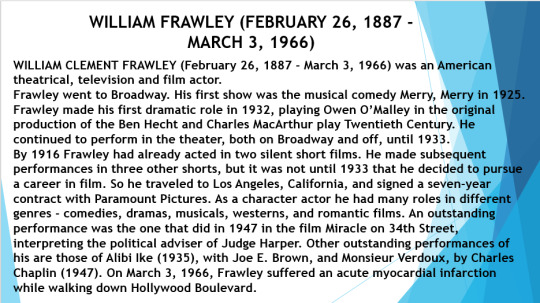

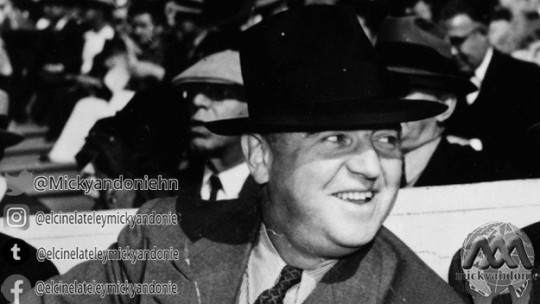
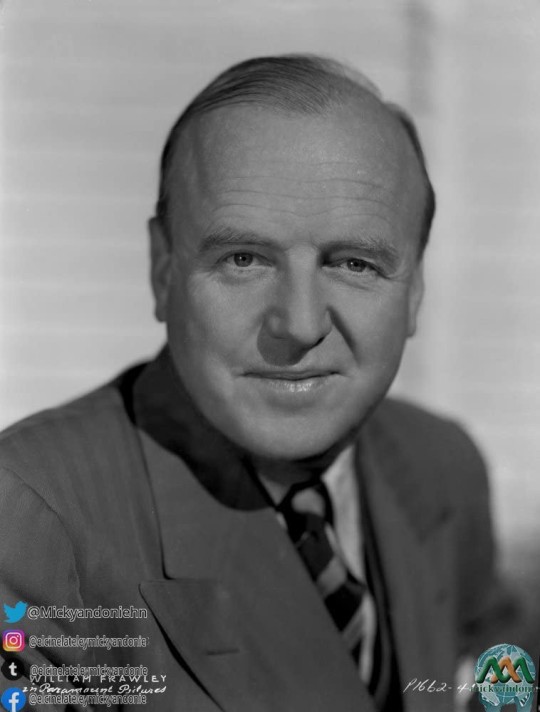

WILLIAM FRAWLEY.
Filmography
Movie theater
1916 Lord Loveland Discovers America
1916 Persisent Percival
1925 Should Husbands Be Watched?
1929 Turkey for Two
1929 Fancy That
1933 Moonlight and Pretzels
1933 Hell and High Water
1934 Miss Fane's Baby Is Stolen
1934 Bolero
1934 The Crime Doctor
1934 The Witching Hour
1934 Shoot the Works
1934 The Lemon Drop Kid
1934 Here Is My Heart
1935 Car 99
1935 Roberta
1935 Hold 'Em Yale
1935 Alibi Ike
1935 College Scandal
1935 Welcome Home
1935 It's a Great Life
1935 Harmony Lane)
1935 Ship Cafe
1936 Strike Me Pink
1936 Desire
1936 F-Man
1936 The Princess Comes Across
1936 Three Cheers for Love
1936 The General Died at Dawn
1936 Three Married Men
Rose bowl
1937 High, Wide, and Handsome
1937 Double or Nothing
1937 The Dangers of Glory
1937 Blossoms on Broadway
1938 Mad About Music
1938 Professor Beware
1938 Sons of the Legion
1939 Ambush
1939 St. Louis Blues
1939 Persons in Hiding
1939 The Adventures of Huckleberry Finn
1939 Rose of Washington Square
1939 Ex-Champ
1939 Grand Jury Secrets
1939 Night Work
1939 Stop, Look and Love
1940 The Farmer's Daughter
1940 Opened by Mistake
1940 Those Were the Days!
1940 Untamed
1940 Golden Gloves
1940 Rhythm on the River
1940 The Quarterback
1940 One Night in the Tropics
1940 Dancing on a Dime
1940 Sandy Gets Her Man
1941 Six Lessons from Madame La Zonga
1941 Footsteps in the Dark
1941 Blondie
1941 The Bride Came C.O.D.
1941 Cracked Nuts
1941 Public Enemies
1942 Treat 'Em Rough
1943 We've Never Been Licked
1943 Larceny with Music
1943 Whistling in Brooklyn
1944 The Fighting Seabees
1944 Going My Way
1944 Minstrel Man
1944 Lake Placid Serenade
1945 Flame of Barbary Coast
1945 Hitchhike to Happiness
1945 Lady on a Train
1946 Ziegfeld Follies
1948 Good Sam
1948 The Babe Ruth Story
1948 Joe Palooka in Winner Take All
1948 The Girl from Manhattan
1949 Chicken Every Sunday
1950 blondie
1950 Kill the Umpire
1950 Kiss Tomorrow Goodbye
1950 Pretty Baby
1951 Abbott and Costello Meet the 1951 1951 Invisible Man
1951 The Lemon Drop Kid
1951 Rhubarb
1952 Notorious Ranch
1953 I Love Lucy
1954 The Dirty Look
1954 Better Football
1962 Safe at Home !.
TV
1951-1957 I Love Lucy
1957-1960 The Lucille Ball-Desi Arnaz Show
1960-1965 My Three Sons)
1965 The Lucy Show.
Work on broadway
1925 -1926 Merry, Merry
1927 Bye, Bye, Bonnie
1928 She's My Baby
1928 Here's Howe
1929-1930 Sons O 'Guns
1931 She Lived Next to the Firehouse
1932 Tell Her the Truth
1932-1933 Twentieth Century
1933 The Ghost Writer.
Créditos: Tomado de Wikipedia
https://es.wikipedia.org/wiki/William_Frawley
#HONDURASQUEDATEENCASA
#ELCINELATELEYMICKYANDONIE
0 notes
Photo

Marathon training is a constant struggle for me. I didn’t want to run this morning. When the alarm went off at 5:30 am, I wanted to roll over and go back to sleep. Somewhere in that half awake state I heard my grandfather’s words, “keep your eye on the ball, son. You’ll never achieve your goals if you don’t remain focussed.” Before you know it, I was lacing up my running shoes and heading out the door for a 5 miler. Thanks for the push Poppie. William “Wild Bill” McCall BORN: JULY 29, 1909, MUSKEGON, MI DIED: OCTOBER 6, 1988, DAYTON, OH A two‑time All‑Stater at Muskegon High School, Bill McCall led the Big Reds to state football titles in 1926 and 1927. He was selected by The Detroit News as quarterback of their third team in 1926, and earned first‑team honors one year later, as a senior On the basketball court, McCall led Muskegon to a 20‑1 record and a Class A state championship in the spring of 1927. After the state tourney, the Big Reds traveled to Chicago to compete in the University of Chicago’s National Cage Tournament, losing to Batesville High School of Arkansas in the second round. McCall moved on to Dartmouth University, where he earned the nickname “Wild Bill” because of his reputation as an “all‑purpose threat.” He showed his versatility in a 33‑all tie against Yale in 1931, scoring three touchdowns, including a 93‑yard kickoff return, an 85‑yard pass reception and a 65‑yard interception return. McCall, who scored 90 points during his senior year, was a strong candidate for Grantland Rice’s All‑American team. His point total ranked fourth on Dartmouth’s all‑time list. McCall also led Dartmouth’s basketball team to a 15‑6 record during his senior year. In three years of cage action, he scored 146 points in 31 games.
3 notes
·
View notes
Text
LUCY THE FIXER
S1;E14 ~ January 6, 1969
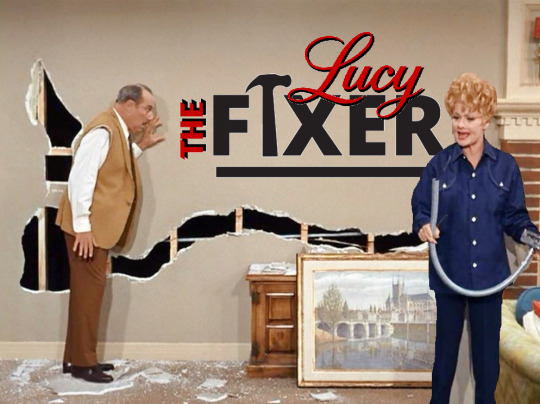

Directed by Jack Donohue ~ Written by Milt Josefsberg and Ray Singer
Synopsis
When Lucy called to Harry's house to take dictation, she tries to fix a broken lamp. In the process she succeeds in nearly wrecking Harry's home!
Regular Cast
Lucille Ball (Lucy Carter), Gale Gordon (Harrison Otis Carter), Lucie Arnaz (Kim Carter), Desi Arnaz Jr. (Craig Carter)

This is the first episode of 1969. It is one of the few to feature just the principal cast members. It is the only one to only include the entire Carter Family!
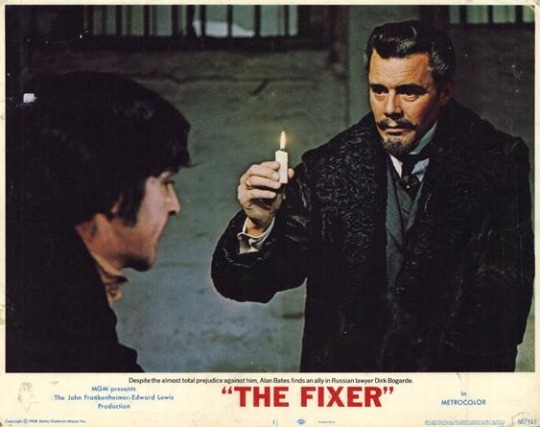
Coincidentally, the title is the same as the 1968 film The Fixer, which would soon be nominated for Golden Globes and Oscars. The plots, however, have no similarity.
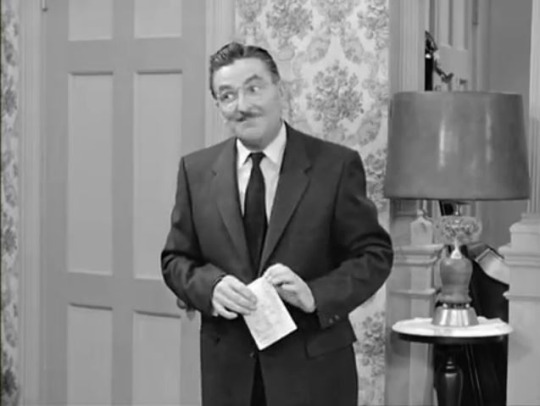
Three days before this episode first aired, Desilu regular Howard McNear died at age 68. He was best known as Floyd the barber on “The Andy Griffith Show” but also appeared with Lucille Ball and Desi Arnaz in The Long, Long Trailer (1954) and as Mr. Crawford, Little Ricky’s music teacher in “Little Ricky Gets Stage Fright” (ILL S6;E4).
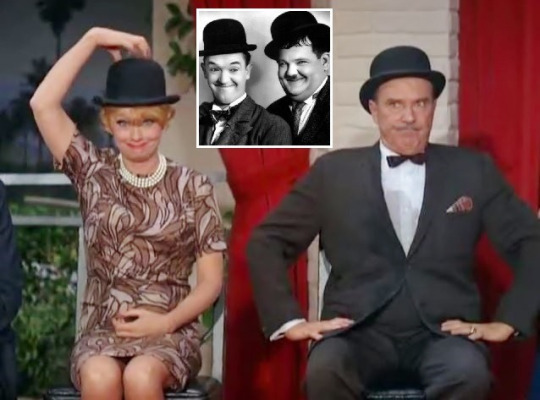
In her introduction to the episode on DVD, Lucie Arnaz compared her mother and Gale Gordon's physical comedy to that of Laurel and Hardy, a comparison that has also been made by others. As Lucy Carmichael and Mr. Mooney, the pair pantomimed being Laurel and Hardy under the spell of Miss Pat, the Hip Hypnotist in “Lucy and Pat Collins” (TLS S5;E11). After Stan Laurel’s death, Lucille Ball appeared on “A Salute to Stan Laurel” which aired on November 23, 1965.
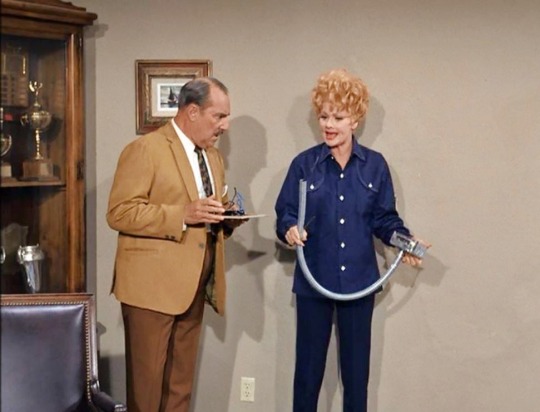
Although Lucille Ball Productions (LBP) may have saved money on actor salaries with this episode, the production costs must have increased substantially as Lucy had to destroy Harry's living room – not once but several times. Lucille Ball was a stickler for rehearsals, so the entire set had to be reconstructed from scratch between rehearsals and filming.
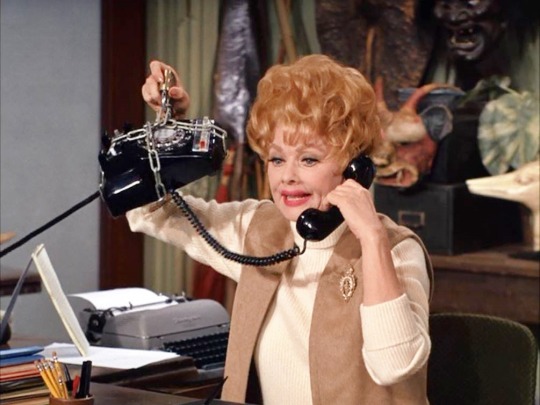
At the office, Lucy gets a call from her friend Isabel - if only for the sake of a visual gag of locking the telephone with a chain and padlock. Two weeks later, Isabel will make her first of two appearances played by Lucille Ball’s old friend Mary Wickes. Although the Isabel disappears, Wickes goes on to create 7 more characters on “Here’s Lucy.”

Thrifty Uncle Harry scolds Lucy for wasting office supplies! He calculates that she has wasted 6 sheets of paper a day, which amounts to 30 sheets a week, 1560 sheets a year, and 15,600 in a decade! This was pre-recycling!
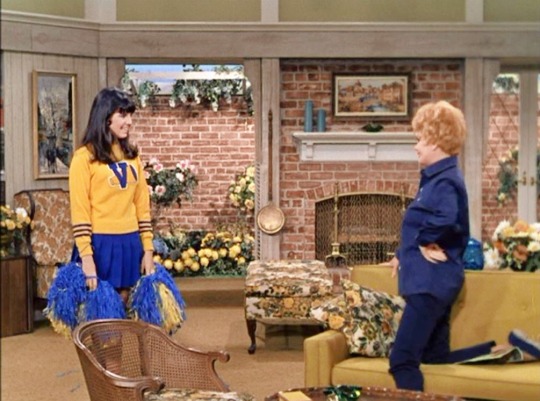
“Rip ‘em with a beat,
Tear ‘em with a paw,
Throw ‘em in the meat grinder
Rah rah rah!”
We discover that Kim is a cheerleader. Lucy says she was also a high school cheerleader and was voted Miss Cheerleader of 193--... Needless to say, the decade is as much as Lucy is willing to share. In real life, had Lucille Ball stayed in high school instead of heading to New York City to seek fame and fortune, the decade would have been the 1920s, not the '30s.
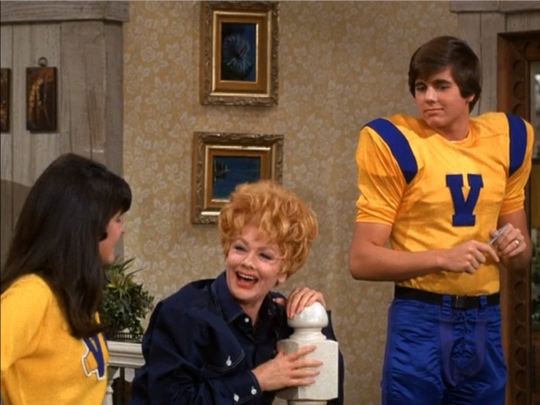
Craig is on the football team – he is a substitute offensive guard on the third team. But he looks good in his uniform! Lucy reminds him that John Wayne started out as an extra. Wayne's first twenty films from 1926 to 1930 were as an uncredited background performer. The eventual Oscar winner was a favorite of Lucille Ball's, appearing as himself on both “I Love Lucy” and “The Lucy Show.” He was mentioned on “Here's Lucy” in “Lucy, the Matchmaker” (S1;E12) and “Lucy and Eva Gabor” (S1;E7).

In a 1972 episode, college student Craig ponders switching from tennis (Desi Jr.’s real-life passion), to football, with some encouragement from guest star Joe Namath. This was the last appearance of Craig Carter.
When Craig says he wants to show his football inform to some friends, Lucy guesses that he means Danny and Steve. Lucie adds Carol and Susie and Doreen and Eileen and Josephine and Betty. Interestingly, she doesn't add Annie, Lori, or Elsie - all female friends of Craig's mentioned (but not seen) in previous episodes. This is likely because the episodes were written by different writers.
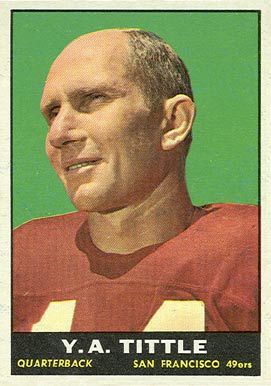
Lucie says her brother is the “Y.A. Tittle of the teenybopper set.” Yelberton Abraham Tittle Jr. (1926-2017), better known as Y.A. Tittle, was a professional football quarterback who played for the San Francisco 49ers, New York Giants, and Baltimore Colts. His final season was in 1964.

This is the first time we visit Harry's home.

The painting of the Paris suburbs that Harry had hanging on the wall is by K. Chin (1920-95). During W.W.II, K Chin served as a mechanical draftsman with the US Air Corps, during this time he honed in on his skill at creating images with great detail. After working in advertising, Chin spent two years with Norcross Greeting Cards.

When Harry loses his patience with Lucy, he threatens her with physical violence! Lucy tells him to take his arm out of the hole in the wall. Harry says that he can’t.

His reply is a tribute to “The Honeymooners” (1955-56) in which bus driver Ralph Kramden frequently said the same thing to his stoic wife, Alice. Coincidentally, the character of Ralph Kramden (Jackie Gleason) appeared in a wordless cameo in the second episode of “Here’s Lucy”!

When Harry finds a kitten behind the wall, Lucy asks it “What's new pussycat?” That was the title of a 1965 film by Woody Allen and an Oscar-nominated song of the same name by Burt Bacharach and Hal David. The song was made famous by Tom Jones and reached #3 on the pop charts.
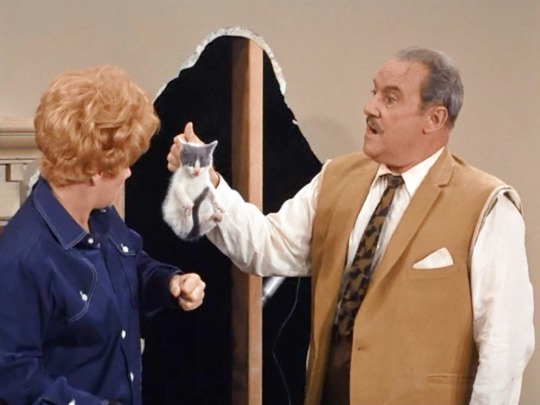
Off the many animals that Lucille Ball has had on her shows, this is the first time she has ever worked with a house cat!

On “Here’s Lucy,” wherever there's water, Gale Gordon will get wet! Kim finds what she thinks are wires, but turn out to be pipes – pointed right at Uncle Harry. This was a running gag on “The Lucy Show” and “Here's Lucy.”

Harry wants to dictate a letter to Rylander Moser and Tibbet. This is the same firm Mr. Mooney (Gale Gordon) often mentioned on “The Lucy Show.”

On “The Lucy Show,” Lucy Carmichael's daughter Chris was a cheerleader and her son Jerry was a football player. Like Lucy Carter, Lucy Carmichael was also a cheerleader in school. Coincidentally, both times her school colors were blue and yellow.
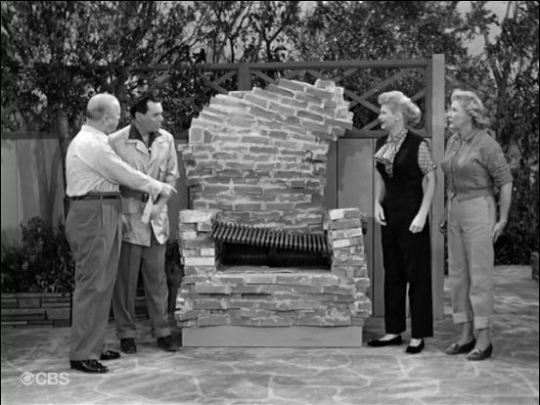
After the carnage to his living room, Harry calls his sister-in-law “Hurricane Lucy.” On “I Love Lucy,” when Lucy and Ethel make a mess of reconstructing their Connecticut barbecue, Ricky guesses that it was caused by “Hurricane Lucy and Hurricane Ethel.” In 1971, a real Hurricane Lucy hit the Philippines.
FAST FORWARD!

A clip from this episode was part of “Lucy and Harry’s Memoirs” (S5;E24), closing up the Unique Employment Agency while slowly getting drunk on champagne. It was intended to be the final episode of the series, until Lucille Ball was convinced to do a sixth season. Like "Lucy the Fixer”, the only characters are the Carter family, although Craig and Kim are only seen in archival footage.
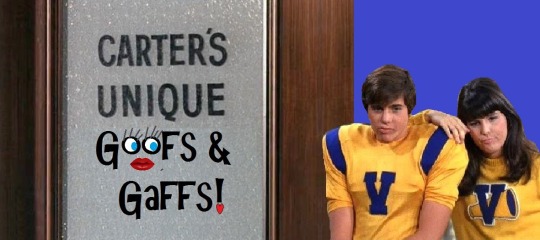
Make-Up! In close-ups of Gale Gordon, viewers can see the stage make-up smudges on his white shirt collar.
Wardrobe! After the commercial break in the destruction scene, Lucy is suddenly wearing blue gloves. Naturally, they perfectly match her outfit!
Sitcom Logic Alert! Harry finds a live kitten living behind his wall. He then simply sets it down outside the living room door saying “go home”! It is never mentioned again! Not only did a kitten survive behind the walls of a home, but it let itself out the front door!

Equipment in Frame! When Kim is looking for the lost wires, the camera pulls back for a wide shot and viewers can see the stage lighting near the top of the frame.
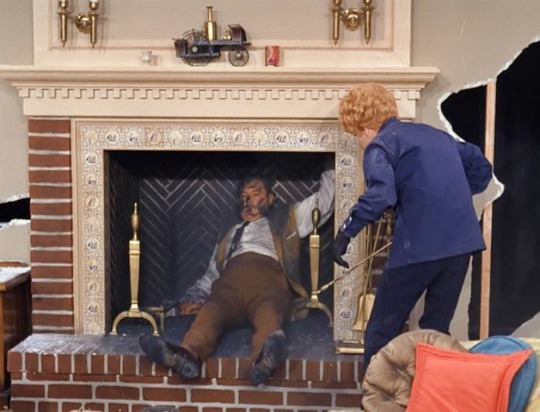
Stunt-Ready Set! To facilitate the stunts, the fireplace has no screen or grate, although the production designers did remember ashes!

“Lucy the Fixer” rates 5 Paper Hearts out of 5
Although the first act drags a bit, the second half is some of the best prop comedy Lucille Ball has done since “I Love Lucy”. It is also a great example of the comic timing of Gale Gordon.

#Here's Lucy#Lucille Ball#Gale Gordon#Lucy the fixer#Lucie Arnaz#Desi Arnaz Jr.#1969#CBS#TV#John Wayne#Laurel and Hardy#What's New Pussycat#Y.A. Tittle#Football#Cheerleader#The Fixer
4 notes
·
View notes
Photo

To mark the Bears’ 100th season, we’re counting down the 100 greatest players in franchise history. Coming in at No. 34 is halfback/quarterback Paddy Driscoll. ⠀ ⠀ Before Red Grange got the spotlight, Driscoll was the real star attraction of Chicago football — for the South Side’s Cardinals, not the North Side’s Bears. But fate would favor the Bears, who were able to acquire the all-around talent in 1926. Things didn’t work out the Cardinals, who had only one winning season in the 20 years following Driscoll’s departure. An All-Pro six times in his career, Driscoll played 56 games over 4 seasons with the Bears from 1926-1929. Follow along as we rank the 100 greatest Bears players and check chicagotribune.com/bears100 for more. (@vintagetribune photo) #bears100 #chicagobears #bears #paddydriscoll https://ift.tt/33a2f9W
0 notes
Text
Mordecai Wyatt Johnson






Mordecai Wyatt Johnson (January 4, 1891 – September 10, 1976) was an American educator and pastor. He served as the first black president of Howard University, from 1926 until 1960. Johnson has been considered one of the three leading African-American preachers of the early 20th-century, along with Vernon Johns and Howard Thurman.
Early life
Johnson was born on January 12, 1890, in Paris, Tennessee. His parents were former slaves, his father was Reverend Wyatt J. Johnson and Carolyn Freeman (a preacher and mill worker) and his mother was a domestic worker for one of the prominent families in town.
Education
Mordecai studied primary school on a small elementary school in his native town. After it, he moved to Nashville where studied at Roger Williams University, then Memphis at Howe Institute in Memphis.
Later was transferred to the Atlanta Baptist College (now Morehouse College) where he completed his secondary and undergraduate education. During his college career, he was a member of the debating team and the Glee Club, a star athlete in three sports, and quarterback of the football team. Offered a faculty position at the college upon graduation, he taught English and economics and served a year as acting dean. He maintained a profound interest in economics throughout his career—an interest that was apparent in some of his major addresses.
After one year of teaching, he continued his education at the University of Chicago, where he received a second A.B. degree, and at the Rochester Theological Seminary in Rochester, New York, where he earned the B.D. degree. At Rochester he was profoundly influenced by the great "social gospel" advocate, Walter Rauchenbusch. His experiences there made an indelible impact upon his thinking and his entire career.
Johnson received his B.A. from Morehouse College in 1911, and second bachelor of arts degree from the University of Chicago two years later. He studied at several other institutions of higher education, including the Rochester Theological Seminary, Harvard University, Howard University, and the Gammon Theological Seminary.
Family
Mordecai Wyatt Johnson married Anna Ethelyn Gardner on December 25, 1916. They had five children: Carolyn Elizabeth Johnson, Mordecai Wyatt Johnson, Jr., Archer Clement Johnson, William Howard Johnson, and Anna Faith Johnson.
Career
Following a brief stint as secretary of the western region of the Student Young Men's Christian Association (YMCA), in 1917 he became pastor of the First Baptist Church in Charleston, West Virginia. He later founded a chapter of the National Association for the Advancement of Colored People (NAACP).
Presidency of Howard University
On June 26, 1926, at the age of 36, Johnson was unanimously elected the eleventh President of Howard University, becoming the first African American to serve as the permanent head of that institution. Prior to his appointment Johnson had served as Professor of Economics and History at Morehouse. He had also served as Pastor of the First Baptist Church in Charleston, West Virginia.
During his tenure, Johnson appointed Charles Hamilton Houston as dean of the law school, and whom played a significant role in dismantling the Jim Crow laws.
Johnson raised millions of dollars for new buildings and for upgrading all of the schools. National honor societies, including Phi Beta Kappa, were established on the campus of Howard.
During his administration, it was said that Howard had the greatest collection of African American scholars to be found anywhere. Notable scholars at Howard included:
Alain Locke, graduated from English and Philosophy at Harvard, and was the first African American Rhodes Scholar,
Ralph Bunche, professor of political science and later a Nobel Laureate;
Charles Drew, who perfected the use of blood plasma;
Percy Julian, a noted chemist;
and Sterling Brown, professor of English and noted Harlem Renaissance poet.
Johnson bring Howard university into national prominence and served as president of Howard for 34 years, since 1926 until his retiredment in 1960. In this time the enrollment at Howard University increased from 2,000 in 1926 to more than 10,000 in 1960.
Johnson the Orator
Johnson was an annual speaker for the Education Night at the National Baptist Convention, a speaker at the Ford Hall Forum in Boston, and spoke alongside Dr. Martin Luther King Jr. and others at the 1957 Prayer Pilgrimage for Freedom. He traveled 25,000 miles a year throughout the country speaking principally on topics such as racism, segregation, and discrimination. In 1951 he was a member of the American delegation to the North Atlantic Treaty Organization (NATO) that met in London.
Awards and recognitions
In 1929, the National Association for the Advancement of Colored People (NAACP) awarded Johnson the Spingarn Medal (its highest honor at that time), for Johnson's ability to secure annual federal funds to support the university's financial future.
Death
Mordecai Wyatt Johnson died on September 10, 1976, at the age of 86, in Washington, D.C.
Wikipedia
9 notes
·
View notes